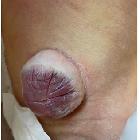Arnold-Chiari-Malformation Typ 2




















Chiari II malformations are relatively common congenital malformation of the spine and posterior fossa characterized by myelomeningocele (lumbosacral spina bifida aperta) and a small posterior fossa with descent of the brainstem and cerebellar tonsils and vermis. Numerous associated abnormalities are also frequently encountered.
Terminology
Chiari II malformations are often thought of as a more severe form of the more common Chiari I malformation. However, it is now understood that these entities are the endpoints of distinct disease processes with some overlapping imaging findings. Chiari III and IV malformations are discussed in their respective articles.
It should be noted that the term Arnold-Chiari malformation should no longer be used; see Chiari malformations history and etymology section for more information.
Epidemiology
Chiari II malformations are encountered relatively commonly with an incidence of ~1:1000 live births . When a child is born with a myelomeningocele, the vast majority (~95%) have an associated Chiari II malformation.
Clinical presentation
Given the wide range of anatomical severity, as well as a large number of associated abnormalities that are sometimes encountered, it should be no surprise that the clinical presentation of patients with Chiari II malformations is also varied both in character and severity. The presentation can be divided according to the age of the individual (although most will have lifelong sequelae) as follows :
- neonatal
- myelomeningocele
- brainstem dysfunction resulting in cranial nerve palsies
- neurogenic bladder
- child
- musculoskeletal
- hydrocephalus
- young adult
Pathology
While Chiari I malformation is thought to result from a small posterior fossa, Chiari II occurs due to in utero malformation of the spine and cranial structures resulting in a characteristic displacement of the medulla, fourth ventricle, and cerebellum through the foramen magnum.
As almost all neonatal patients with Chari II have myelomeningocele, it has been suggested that the underlying etiology is that of in utero CSF leak due to open spinal dysraphism. Older patients with Chiari II without myelomeningocele are thought to have had either a smaller neural tube defect or subsequent closure of the defect in utero.
Associations
- spinal
- syringohydromyelia
- scoliosis
- segmentational anomalies (50%)
- Klippel-Feil syndrome
- atlanto-axial assimilation
- diastematomyelia
- cerebral
- corpus callosum dysgenesis
- absent septum pellucidum
- obstructive hydrocephalus
- fenestration of the falx with interdigitated gyri or absent falx; heart shape incisura
- stenogyria/polymicrogyria (probably not the same as polymicrogyria encountered in schizencephaly )
- tectal beaking
- cranial vault
- scalloping of petrous temporal bone
- enlarged foramen magnum
- Luckenschadel skull
- small posterior fossa
- skeletal
Radiographic features
Antenatal ultrasound
Classical signs described on ultrasound include
There may also be evidence of fetal ventriculomegaly due to obstructive effects as a result of downward cerebellar herniation. Additionally, many of the associated malformations (e.g. corpus callosal dysgenesis) may be identified.
MRI
MRI is the modality of choice for detecting and characterizing the full constellation of findings associated with Chiari II malformations. The key features are discussed below, whereas the wide range of associated abnormalities (see above) are discussed separately.
Posterior fossa
- small posterior fossa with a low attachment of the tentorium and low torcula
- the brainstem appears 'pulled' down with an elongated and low-lying fourth ventricle
- the tectal plate appears beaked: the inferior colliculus is elongated and points posteriorly, with resulting angulation of the aqueduct which results in aqueductal stenosis and hydrocephalus
- the cerebellar tonsils and vermis are displaced inferiorly through the foramen magnum, which appears crowded
Spine
- spina bifida aperta / myelomeningocele
- tethered cord
Treatment and prognosis
Treatment of patients with Chiari II malformation is complex due to the variable form and severity of malformations:
- myelomeningocele repair and management of neurogenic bladder
- is performed on the in utero fetus at some centers in select cases to improve outcomes
- ventricular shunting (usually ventriculoperitoneal)
- hydrocephalus usually requires shunting and can help ameliorate cranial nerve and brainstem dysfunction
- craniovertebral decompression
- may also be required in neonates with brainstem dysfunction if hydrocephalus is not present or symptoms and signs do not improve with shunting
- older patients with hindbrain herniation or syringohydromyelia may also benefit
History and etymology
The Chiari malformations were first described in 1891 by Hans Chiari, Austrian pathologist (1851-1916). See the article on Chiari malformations for further details.
Differential diagnosis
The differential is predominantly one of definition, and the term Chiari type II is often inappropriately used to designate a variety of malformations. Provided both myelomeningocele and brainstem descent are present, the diagnosis is usually straightforward :
- Chiari I malformation
- does not have a myelomeningocele
- may occasionally have brainstem descent
- isolated myelomeningocele without posterior fossa abnormality
Siehe auch:
und weiter:
- Spina bifida
- Basiläre Impression
- Syrinx
- obstetric curriculum
- Schizenzephalie
- lemon sign
- neuroradiologisches Curriculum
- Heterotopie der grauen Substanz
- Syringomyelie
- Septo-optische Dysplasie
- Myeloschisis
- enlarged fetal ventricles
- Chiari-Malformation
- basilar invagination (mnemonic)
- fruit inspired signs
- zerebelläre Anomalien
- Septo-optische Dysplasie mit Schizenzephalie
- Bananenzeichen (Kleinhirn)
- fetal MRI in Chiari II malformation
- Arnold Chiari type III malformation
- Interdigitation der Gyri

 Assoziationen und Differentialdiagnosen zu Arnold-Chiari-Malformation Typ 2:
Assoziationen und Differentialdiagnosen zu Arnold-Chiari-Malformation Typ 2:

